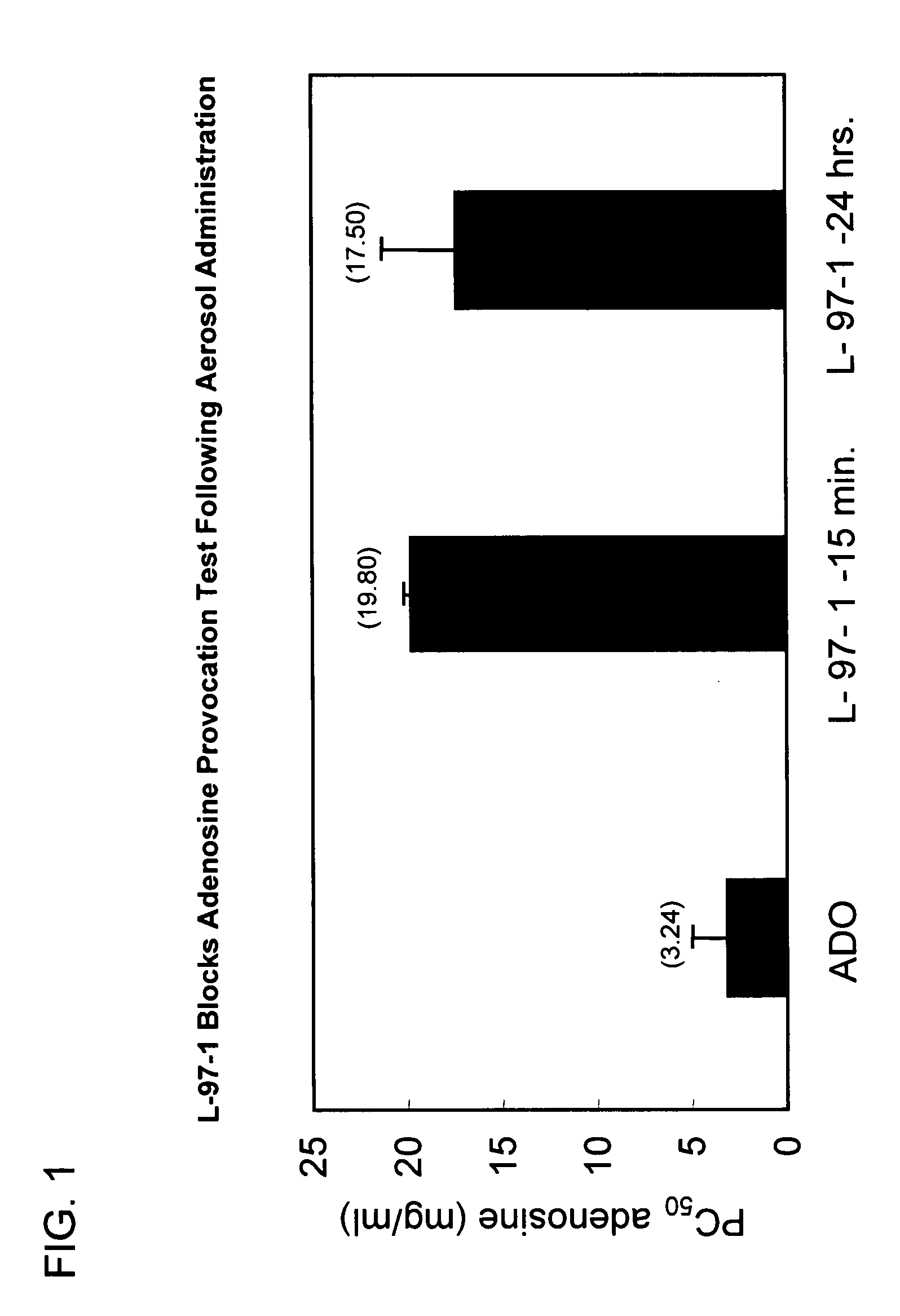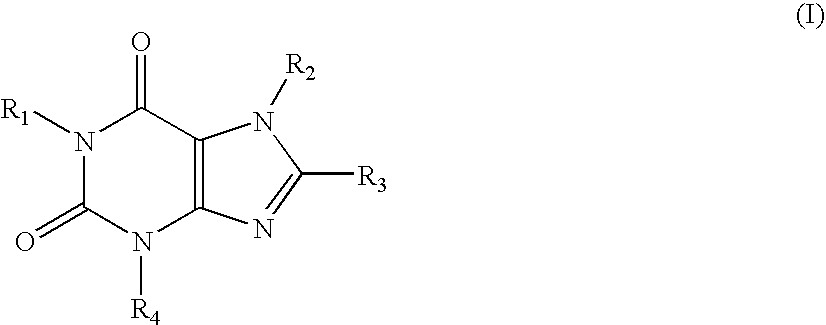Compositions and methods for treating respiratory disorders
a technology for respiratory disorders and compositions, applied in the field of compositions and methods for the treatment and prevention of respiratory disorders, can solve the problems of increased difficulty in air in and out, shortness of breath, wheezing, coughing, etc., and achieve the effects of preventing the development of respiratory disorders, promoting the desired therapeutic response, and preventing the acute onset of symptoms
- Summary
- Abstract
- Description
- Claims
- Application Information
AI Technical Summary
Benefits of technology
Problems solved by technology
Method used
Image
Examples
example 1
L-97-1 Blocks Adenosine Provocation Test Following Aerosol Administration
[0068] L-97-1 was administered as an inhalational treatment before the inhalational administration of adenosine in allergic rabbits. All animals were anesthetized and intubated. All treatments were administered via an endotracheal tube with an ultrasonic nebulizer that produces aerosol droplets (80% are less than 5 μm). Dynamic compliance (Cdyn) was calculated from tidal volume and the difference in transpulmonary pressure (PTP) at zero flow (V). Total lung resistance (RT) was calculated as the ratio of PTP and V at midtidal lung volumes; these measurements are made automatically with the Buxco Respiratory Analyzer. Baseline bronchial hyperresponsiveness (BHR) was established in the allergic rabbits by challenging the rabbits with increasing concentrations of aerosolized histamine. The PC50 for histamine (concentration of histamine to reduce lung compliance by 50%) was determined. The animals were allowed to r...
example 2
Synthesis of L-97-1 Monoxinafoic Acid Salt (L-97-1 Monoxinafoate)
[0071] L-97-1 monoxinafoic acid salt is synthesized according to the process illustrated below:
[0072] A mixture of 518 mg (1.0 mmole) of L-97-1 free base and 188 mg (1.0 mmole) of xinafoic acid (1-hydroxy-2-naphthoic acid) is stirred at room temperature in a suspension with 5.0 ml of deionized water for 24 hours to produce the finely divided insoluble hydrated L-97-1 monoxinafoic acid salt. The off-white solid is collected by filtration and air dried to yield the hydrated form of L-97-1 monoxinafoic acid salt. Depending upon the amount of drying, the 0.5 hydrate, the monohydrate, the 1.5 hydrate, the dihydrate, the 2.5 hydrate, or the trihydrate salt can be formed. Any of these materials can also be heated at 30-40° C. for 1-2 days under 0.1-1 mm vacuum to produce the anhydrate form of L-97-1 monoxinafoic acid salt.
example 3
Synthesis of L-97-1 0.5 Xinafoic Acid Salt (L-97-1 0.5 Xinafoate)
[0073] A mixture of 518 mg (1.0 mmole) of L-97-1 free base and 94 mg (0.5 mmole) of xinafoic acid (1-hydroxy-2-naphthoic acid) is stirred at room temperature in a suspension with 5.0 ml of deionized water for 24 hours to produce the finely divided insoluble hydrated L-97-1 0.5 xinafoic acid salt. The off-white solid can be collected by filtration and air dried to yield the hydrated form of L-97-1 0.5 xinafoic acid salt. Depending upon the amount of drying, the 0.5 hydrate, the monohydrate, the 1.5 hydrate, the dihydrate, the 2.5 hydrate, or the trihydrate salt can be formed. Any of these materials can also be heated at 30-40° C. for 1-2 days under 0.1-1 mm vacuum to produce the anhydrate form of L-97-1 0.5 xinafoic acid salt.
PUM
| Property | Measurement | Unit |
|---|---|---|
| mean diameter | aaaaa | aaaaa |
| mean diameter | aaaaa | aaaaa |
| mean diameter | aaaaa | aaaaa |
Abstract
Description
Claims
Application Information
 Login to View More
Login to View More - R&D
- Intellectual Property
- Life Sciences
- Materials
- Tech Scout
- Unparalleled Data Quality
- Higher Quality Content
- 60% Fewer Hallucinations
Browse by: Latest US Patents, China's latest patents, Technical Efficacy Thesaurus, Application Domain, Technology Topic, Popular Technical Reports.
© 2025 PatSnap. All rights reserved.Legal|Privacy policy|Modern Slavery Act Transparency Statement|Sitemap|About US| Contact US: help@patsnap.com



